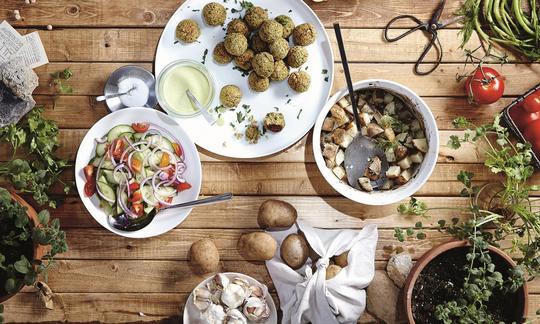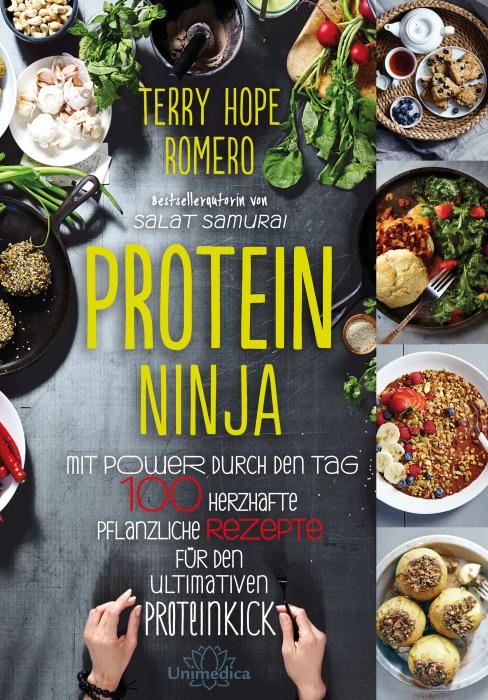Falafel Bowl with Roasted Potatoes and Mediterranean Salad
vegan
Ingredients (for servings, )
Equipment
- blender or hand-held blender / immersion blender
- baking pan (springform pan)
- citrus juicer (lemon squeezer)
- oven
- baking sheet (cookie sheet)
- sieve
Type of preparation
- bake
- chop or grind
- soak
- blend
- squeeze
- cool
- season to taste
- purée
- remove the skin
- marinate
Preparation
Preparing the falafel
If you do not have any prepared falafel balls, you can find the ingredients and directions for making them here: Baked Green Falafel.You can bake the falafel (step 5 of the Baked Green Falafel recipe) with the potatoes in this recipe (step 6, below).
Preparing the ingredients for the dressing
Soak the cashews in warm water for at least 20 minutes. Squeeze the fresh lemon and peel the garlic cloves. Set the juice and garlic to the side until ready to use and continue with the further preparation steps.Preparing the lemon roasted potatoes
Mince the garlic and dill and then add them to a 3 L (3 qt) ovenproof baking dish (adjust the size of the dish depending on the quantity you are preparing) along with the broth, lemon juice, and oregano. Whisk the mixture with a fork.This recipe makes 5 servings. The author recommends using either 2 teaspoons dried or 1 tablespoon fresh oregano. He also includes 1 teaspoon salt, which we have omitted because of the salt in the vegetable broth.
Preparing the basil lemon cashew dressing
Purée the soaked cashews with the water they were soaked in and the rest of the dressing ingredients until smooth. Chill until ready to use.We have purposely reduced the amount of salt, using a pinch rather than a ½ teaspoon for 5 servings.
Preparing the roasted potatoes and baking the falafel
Preheat the oven to 200 °C (400 °F) Cut the (unpeeled) potatoes into 2½ cm (1 inch) cubes. Add the potatoes to the baking dish with the marinade and stir until they are evenly coated. Cover the dish with foil and crimp the edges to create a tight seal. Bake for 20 minutes . Continue with the falafel.The author uses russet potatoes, which are starchy when cooked. You can also use any other type of starchy potato.
Spray or brush the falafel balls with olive oil and add them to the oven with the potatoes. Bake until they are firm and the bottoms are golden brown, about 22–24 minutes. Make the chopped Mediterranean salad while the falafel and potatoes are baking.
For the chopped Mediterranean salad
Slice the cucumber, halve the cherry tomatoes, peel and chop the onion. Squeeze the juice of the lemon and pour into a bowl and then add the prepared vegetables. Sesaon with salt and pepper to taste.For this recipe, the author recommends using Persian cucumbers and one large red onion.
Finish the potatoes and falafel
Remove the foil from the potatoes. Stir the potatoes and bake uncovered for an additional 8–10 minutes, until they are browned but not dry.Remove the falafel from the oven when nicely browned and keep warm until serving.
Serve
Place a generous portion of the roasted potatoes in a large, shallow serving bowl. Add the chopped salad and arrange the falafel on top. Drizzle some of the basil lemon cashew dressing over the dish and serve the remaining dressing in a separate container on the side.
|
Nutritional Information per person
Convert per 100g
|
2000 kcal | |
|---|---|---|
| Energy | 472 kcal | 23.6% |
| Fat/Lipids | 17 g | 24.4% |
| Saturated Fats | 2.6 g | 13.1% |
| Carbohydrates (inc.dietary fiber) | 71 g | 26.3% |
| Sugars | 9.9 g | 11.0% |
| Fiber | 9.3 g | 37.2% |
| Protein/Albumin | 15 g | 30.3% |
| Cooking Salt (Na:212.6 mg) | 540 mg | 22.5% |
| Essential micronutrients with the highest proportions | per person | 2000 kcal | |
|---|---|---|---|
| Vit | Vitamin K | 82 µg | 110.0% |
| Vit | Vitamin B9, B11 (Folate, as the active form of folic acid) | 208 µg | 104.0% |
| Min | Copper, Cu | 0.88 mg | 88.0% |
| Min | Manganese, Mn | 1.7 mg | 87.0% |
| Vit | Vitamin B6 (pyridoxine) | 1.1 mg | 76.0% |
| Elem | Potassium, K | 1'478 mg | 74.0% |
| Prot | Tryptophan (Trp, W) | 0.17 g | 67.0% |
| Vit | Vitamin C (ascorbic acid) | 48 mg | 60.0% |
| Prot | Threonine (Thr, T) | 0.51 g | 55.0% |
| Elem | Phosphorus, P | 373 mg | 53.0% |
Detailed Nutritional Information per Person for this Recipe
The majority of the nutritional information comes from the USDA (US Department of Agriculture). This means that the information for natural products is often incomplete or only given within broader categories, whereas in most cases products made from these have more complete information displayed.
If we take flaxseed, for example, the important essential amino acid ALA (omega-3) is only included in an overarching category whereas for flaxseed oil ALA is listed specifically. In time, we will be able to change this, but it will require a lot of work. An “i” appears behind ingredients that have been adjusted and an explanation appears when you hover over this symbol.
For Erb Muesli, the original calculations resulted in 48 % of the daily requirement of ALA — but with the correction, we see that the muesli actually covers >100 % of the necessary recommendation for the omega-3 fatty acid ALA. Our goal is to eventually be able to compare the nutritional value of our recipes with those that are used in conventional western lifestyles.
| Essential fatty acids | per person | 2000 kcal |
|---|---|---|
| Linoleic acid; LA; 18:2 omega-6 | 2.8 g | 28.0% |
| Alpha-Linolenic acid; ALA; 18:3 omega-3 | 0.16 g | 8.0% |
| Essential amino acids | per person | 2000 kcal |
|---|---|---|
| Tryptophan (Trp, W) | 0.17 g | 67.0% |
| Threonine (Thr, T) | 0.51 g | 55.0% |
| Isoleucine (Ile, I) | 0.55 g | 45.0% |
| Phenylalanine (Phe, F) | 0.68 g | 44.0% |
| Lysine (Lys, K) | 0.79 g | 42.0% |
| Valine (Val, V) | 0.68 g | 42.0% |
| Leucine (Leu, L) | 0.92 g | 38.0% |
| Methionine (Met, M) | 0.22 g | 23.0% |
| Vitamins | per person | 2000 kcal |
|---|---|---|
| Vitamin K | 82 µg | 110.0% |
| Vitamin B9, B11 (Folate, as the active form of folic acid) | 208 µg | 104.0% |
| Vitamin B6 (pyridoxine) | 1.1 mg | 76.0% |
| Vitamin C (ascorbic acid) | 48 mg | 60.0% |
| Vitamin B1 (Thiamine) | 0.45 mg | 41.0% |
| Vitamin B5 (Pantothenic acid) | 1.5 mg | 24.0% |
| Vitamin B3 (Niacin) | 3.6 mg | 22.0% |
| Vitamin E, as a-TEs | 2.1 mg | 18.0% |
| Vitamin B2 (Riboflavin) | 0.20 mg | 15.0% |
| Vitamin B7 (Biotin, ex vitamin H) | 5.9 µg | 12.0% |
| Vitamin A, as RAE | 88 µg | 11.0% |
| Essential macroelements (macronutrients) | per person | 2000 kcal |
|---|---|---|
| Potassium, K | 1'478 mg | 74.0% |
| Phosphorus, P | 373 mg | 53.0% |
| Magnesium, Mg | 150 mg | 40.0% |
| Sodium, Na | 213 mg | 27.0% |
| Calcium, Ca | 121 mg | 15.0% |
| Essential trace elements (micronutrients) | per person | 2000 kcal |
|---|---|---|
| Copper, Cu | 0.88 mg | 88.0% |
| Manganese, Mn | 1.7 mg | 87.0% |
| Iron, Fe | 5.6 mg | 40.0% |
| Zinc, Zn | 2.8 mg | 28.0% |
| Selenium, Se | 9.6 µg | 18.0% |
| Iod, I (Jod, J) | 6.7 µg | 4.0% |
| Fluorine, F | 30 µg | 1.0% |
Narayana Verlag GmbH /Unimedica Verlag , Terry Hope Romero
Raw recipes 7, Cooked recipes 87 (4)
Additional photos (15)
In "Protein Ninja" by Terry Hope Romero, you'll learn how you can eat a protein-rich diet as a vegan in a variety of ways.
Since this book is written in German, a description is omitted here. If you are interested, please switch to German in the menu.
This falafel bowl with lemon roasted potatoes, a basil lemon cashew dressing, and a chopped Mediterranean salad will satisfy even the most ravenous hunger.
Serving sizes: The author indicates that this recipe makes for 4 servings. We suggest that it is enough to serve 5 people. If someone has a real case of “Ninja” hunger, you can serve them additional falafel or pita bread.
The original recipe uses the Baked Green Falafel with Pea Protein recipe listed on p.142 of “Protein Ninja.” You can find the ingredients and directions for making them here: Baked Green Falafel by Terry Hope Romero.
This recipe calls for prepared falafel balls. We did not include the ingredients and preparation of the falafel balls in this recipe.
Making the falafel as part of the recipe: If you want to make your own falafel balls as part of this recipe, begin preparing them before you make the basil lemon cashew dressing (step 2).
Preparation time: The preparation time listed for this recipe does not include the time required if you make the falafel from scratch. You will need an additional 20–30 minutes to make falafel balls (if you are using presoaked and precooked chickpeas). However, if you want to achieve the best flavor and consistency, we would recommend that you use dried chickpeas. If you choose to do so, then you will need an additional 8 hours for soaking (soaking overnight or the day before works best).
Russet potatoes: Russet potatoes are the most widely grown potatoes in North America. They are large white potatoes with a dark skin that have a high starch content. Russet potatoes are good for baking, mashing, and making french fries. Like other starchy potatoes, they have a dry, mealy texture and an earthy, distinct potato flavor with skin that tends to split open when cooked.
Cucumbers: Cucumbers (Cucumis sativus) are a member of the gourd family and are characterized by the creeping vine that they grow on. The original wild variety of the cucumber probably originated in India, but now grows on most continents. There are three main varieties of cucumber: slicing, pickling, and seedless. Within these varieties, several cultivars have been created. The cucumber is classified as a pepo, a type of botanical berry with a hard outer rind and no internal divisions — in other words, like a gourd. Cucumbers consist of over 90–96 % water and are a very refreshing, low-calorie vegetable. While both slicing and seedless cucumbers are served raw in most Western countries, cucumbers are often served cooked as a side vegetable in some Asian countries.
Storing the falafel batter or falafel balls: If you want to make extra falafel batter or falafel balls or if you made more than you planned to, don’t worry — both the batter and the prepared falafel balls store well when tightly covered in the refrigerator. You can refrigerate the batter for up to five days without losing any flavor, while the falafel balls may lose some of their crispness.
The author recommends: “You can serve nice, thick pita bread with this to dip in the juice from the potatoes and the salad dressing. Your favorite chili sauce is also great with this meal.”
Basil lemon cashew dressing: If you want to add more flavor to the dressing, you can double the amount of lemon juice and add some cayenne pepper.




